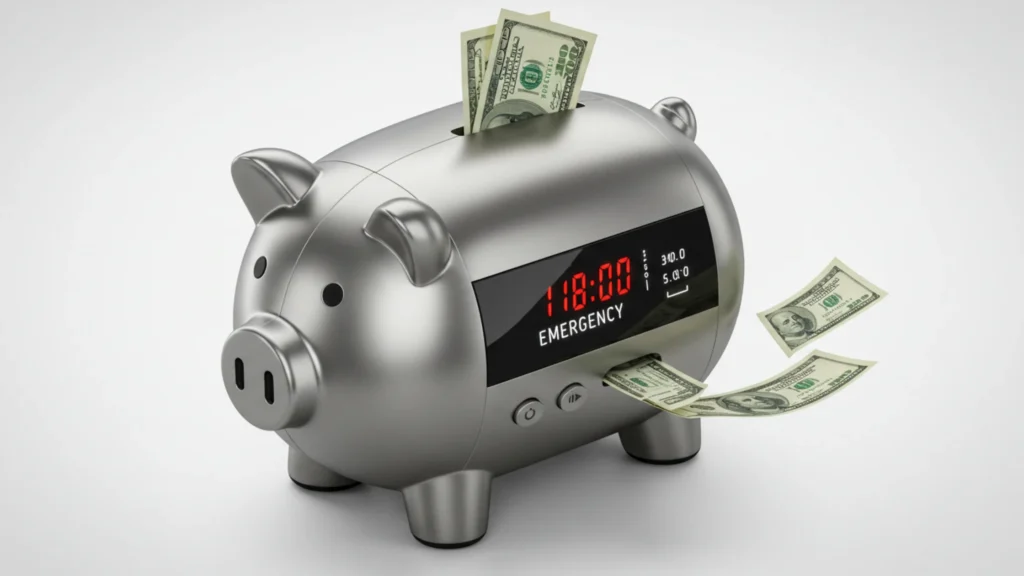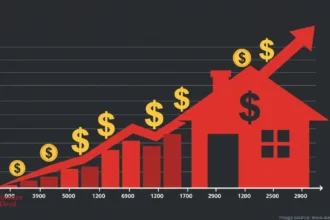
Introduction: Why Emergency Fund Building Matters Now More Than Ever
In today’s uncertain economic landscape, emergency fund building has become a cornerstone of financial stability for Americans. Recent studies paint a concerning picture: according to a 2024 Bankrate survey, only 44% of Americans could cover a $1,000 emergency from their savings, while 63% report that rising inflation is causing them to save less for emergencies. With unexpected expenses like medical bills, car repairs, or sudden job loss looming as potential financial disruptions, having a dedicated safety net has never been more crucial.
This comprehensive guide will walk you through everything you need to know about emergency fund building in the USA, from understanding what it is and why it matters to practical, actionable steps for creating and maintaining one that works for your unique situation. Whether you’re starting from scratch or looking to optimize your existing emergency savings strategy, this resource will help you build financial resilience in an increasingly unpredictable world.
What Is an Emergency Fund?
An emergency fund is a dedicated cash reserve specifically designed to cover unexpected financial expenses, preventing you from relying on credit cards, loans, or your regular savings accounts during times of crisis. Unlike other savings vehicles earmarked for specific goals like vacations or retirement, an emergency fund serves as your financial first line of defense when life throws unexpected challenges your way.
The Purpose of an Emergency Fund
The primary purpose of emergency fund building is to create a financial buffer that helps you navigate through life’s unexpected situations without derailing your broader financial plans. This safety net ensures you don’t have to:
- Rack up high-interest credit card debt
- Take out costly personal loans
- Raid your retirement accounts (potentially incurring penalties)
- Sell investments at inopportune times
- Ask family or friends for financial assistance
What Constitutes a True Emergency?
Understanding what qualifies as an emergency is crucial for proper emergency fund building and maintenance. True emergencies typically include:
- Job loss or significant reduction in income
- Urgent medical or dental expenses not covered by insurance
- Essential home repairs (like a broken furnace in winter or severe roof damage)
- Major car repairs when your vehicle is necessary for work
- Unexpected travel due to family emergencies
What doesn’t qualify as an emergency:
- Routine expenses you can anticipate
- Discretionary purchases
- Planned events like weddings or vacations
- Annual expenses like property taxes or insurance premiums
The Financial Benefits of Emergency Fund Building
Developing a robust emergency fund offers numerous financial advantages beyond just covering unexpected expenses:
1. Reduced Financial Stress
Having an emergency fund provides psychological security, knowing you have resources available if something goes wrong. This peace of mind can significantly reduce financial anxiety, which affects approximately 77% of Americans according to the American Psychological Association.
2. Avoidance of High-Interest Debt
When emergencies strike without savings in place, many Americans turn to credit cards or high-interest loans. With average credit card interest rates hovering around 22% in 2025, this can transform a temporary financial setback into a long-term financial burden.
3. Protection for Other Financial Goals
Your emergency fund acts as a protective barrier for your other financial objectives. Without it, you might be forced to tap into college savings, retirement accounts, or other important investments when unexpected expenses arise.
4. Increased Financial Flexibility
With adequate emergency savings, you gain the flexibility to make optimal financial decisions rather than desperate ones. This might mean having the confidence to pursue a better career opportunity or negotiate from a position of strength.
5. Reduced Reliance on Social Safety Nets
While programs like unemployment insurance exist, they often don’t replace your full income and may have limitations. A personal emergency fund supplements these safety nets, giving you more control over your financial well-being.
How Much Should Your Emergency Fund Contain?
The appropriate size of your emergency fund depends on several personal factors, but most financial experts recommend certain guidelines:
Standard Recommendations
The traditional advice for emergency fund building is to save:
- 3-6 months of essential expenses for those with stable employment, multiple income sources, or no dependents
- 6-9 months for those with variable income, single-income households, or families with children
- 9-12 months for self-employed individuals, freelancers, or those in volatile industries
Personalizing Your Emergency Fund Goal
While these guidelines provide a useful starting point, your ideal emergency fund size should be tailored to your specific circumstances:
Factors that may necessitate a larger emergency fund:
- Being the sole income earner in your household
- Working in an industry with high job volatility
- Having specialized skills that might make finding new employment difficult
- Living in an area with a high cost of living
- Having dependents with special needs or medical conditions
- Owning an older home or vehicle that may require more frequent repairs
- Limited disability or health insurance coverage
Factors that might allow for a smaller emergency fund:
- Multiple stable income sources in your household
- Highly marketable skills in a robust job market
- Strong job security
- Comprehensive insurance coverage
- Access to additional financial resources (like a home equity line of credit)
- Minimal fixed financial obligations
Calculating Your Monthly Essential Expenses
To determine how much to save for your emergency fund, start by calculating your essential monthly expenses:
- Housing (mortgage/rent, property taxes, insurance)
- Utilities (electricity, water, gas, internet)
- Food (groceries, not dining out)
- Transportation (car payment, gas, insurance, public transit)
- Healthcare (insurance premiums, regular medications)
- Debt payments (minimum required payments)
- Childcare or dependent care costs
- Cell phone service
- Basic personal care items
Notably, this calculation excludes discretionary spending like entertainment, vacations, gifts, or non-essential shopping. During a true emergency, these expenses would typically be reduced or eliminated.
For example, if your essential monthly expenses total $4,000, a three-month emergency fund would be $12,000, while a six-month fund would be $24,000.
Strategic Approach to Emergency Fund Building
Building an emergency fund requires a methodical approach, especially if you’re starting from zero. Here’s a strategic framework for successful emergency fund building:
Step 1: Create a Starter Emergency Fund
Before aiming for the full 3-6 months of expenses, focus on building a starter emergency fund of $1,000-$2,000. This initial buffer can handle smaller emergencies while you work toward your larger goal.
Step 2: Develop a Comprehensive Budget
Effective emergency fund building requires understanding where your money goes. Create a detailed budget that tracks:
- All income sources
- Fixed expenses
- Variable expenses
- Discretionary spending
This analysis will help identify areas where you can potentially reduce spending to accelerate your emergency fund building.
Step 3: Automate Your Savings
Consistency is key to successful emergency fund building. Set up automatic transfers from your checking account to your emergency fund account:
- Time these transfers to occur right after payday
- Start with a percentage of income you can comfortably save (even if it’s just 1-2%)
- Gradually increase your savings rate as your financial situation improves
Step 4: Leverage Windfalls and Extra Income
Accelerate your emergency fund building by allocating “found money” to your savings:
- Tax refunds
- Work bonuses
- Cash gifts
- Inheritance
- Side hustle income
- Overtime pay
While it might be tempting to use these windfalls for discretionary purchases, directing them to your emergency fund can dramatically speed up your progress.
Step 5: Track Your Progress and Celebrate Milestones
Emergency fund building is a marathon, not a sprint. To maintain motivation:
- Set smaller milestone goals (e.g., $500, $1,000, one month of expenses)
- Track your progress visually with a spreadsheet or app
- Celebrate reaching milestones with small, budget-friendly rewards
Where to Keep Your Emergency Fund
Where you store your emergency fund is just as important as how much you save. The ideal emergency fund location balances accessibility, security, and some growth potential.
Key Considerations for Emergency Fund Placement
When evaluating where to keep your emergency fund, consider these critical factors:
- Liquidity: You should be able to access the funds within 1-2 business days without penalties.
- Safety: The account should be FDIC or NCUA insured to protect your principal.
- Separation: Keep your emergency fund separate from day-to-day checking to reduce temptation to use it for non-emergencies.
- Yield: While growth isn’t the primary goal, earning some interest helps combat inflation.
- Fees: Avoid accounts with monthly maintenance fees that erode your balance.
Best Options for Emergency Fund Building in 2025
Based on these considerations, here are the top vehicles for emergency fund building in today’s financial landscape:
1. High-Yield Savings Accounts (HYSAs)
Pros:
- FDIC/NCUA insured (up to $250,000)
- Competitive interest rates (ranging from 3.5-5.0% APY as of early 2025)
- Highly liquid with easy online access
- No market risk
Cons:
- Slightly slower access than a checking account (1-2 business days for transfers)
- Interest rates may not fully keep pace with inflation
Best for: The majority of your emergency fund (particularly online HYSAs)
2. Money Market Accounts
Pros:
- FDIC/NCUA insured
- Sometimes offer check-writing privileges
- May offer debit card access
- Often pay competitive interest rates
Cons:
- May require higher minimum balances
- Some transaction limitations
- Occasionally higher fees
Best for: Those who want slightly more accessible emergency funds with competitive returns
3. No-Penalty Certificates of Deposit (CDs)
Pros:
- FDIC/NCUA insured
- Higher fixed interest rates than regular savings
- No penalty for early withdrawal
Cons:
- Rates locked at opening (could miss rate increases)
- May require minimum deposit amounts
- Slightly less convenient access
Best for: A portion of a larger emergency fund, particularly in a rising interest rate environment
4. Cash Management Accounts
Pros:
- Often combine features of checking and savings accounts
- Competitive interest rates
- Some offer additional perks like ATM fee reimbursements
Cons:
- Newer products with varying features
- Some may not have physical branch access
Best for: Tech-savvy savers who want to consolidate financial accounts
Where NOT to Keep Your Emergency Fund
As important as knowing the best places for emergency fund building is understanding where you shouldn’t keep these critical savings:
- Long-term CDs with penalties: The withdrawal penalties could significantly reduce your funds when you need them most.
- Investment accounts (stocks, bonds, mutual funds): Market volatility could reduce your balance precisely when you need to access it.
- Retirement accounts: Early withdrawals typically incur penalties and tax consequences.
- Under your mattress or in a safe: Physical cash earns no interest and risks theft or loss.
- Low-interest checking accounts: These typically offer minimal returns compared to dedicated savings vehicles.
Advanced Emergency Fund Building Strategies
Once you’ve established the basics of emergency fund building, consider these more sophisticated approaches to optimize your financial safety net:
Tiered Emergency Fund Approach
Instead of keeping all your emergency savings in a single account, consider a tiered strategy:
Tier 1 (Immediate Access):
- 1 month of expenses in a high-yield savings account linked to your checking
- Purpose: For immediate emergencies requiring same-day access
Tier 2 (Short-Term Emergencies):
- 2-3 months of expenses in a higher-yield but slightly less accessible account
- Purpose: For emergencies that don’t require instant access
Tier 3 (Extended Emergencies):
- 3+ months of expenses in no-penalty CDs or similar higher-yield vehicles
- Purpose: For major life disruptions like extended job loss
Targeted Mini Emergency Funds
In addition to your main emergency fund, consider establishing smaller dedicated funds for specific predictable but irregular expenses:
- Home Maintenance Fund: For inevitable home repairs (1-3% of home value annually)
- Vehicle Fund: For car repairs and eventual replacement
- Medical Fund: For out-of-pocket healthcare costs
- Pet Emergency Fund: For unexpected veterinary expenses
While these aren’t true emergencies in the strictest sense, having dedicated savings for these common irregularities can prevent you from tapping your main emergency fund.
Emergency Fund Building with Limited Income
Building an emergency fund on a tight budget requires creativity and persistence:
- Start extremely small: Even $5-10 per week builds momentum
- Use micro-saving apps: Tools like Acorns or Digit can help painlessly build savings
- Challenge yourself: Try no-spend days/weeks or savings challenges
- Monetize skills: Consider temporary side gigs specifically for emergency fund building
- Review and reduce recurring subscriptions: Many households can save $100+ monthly by eliminating unused subscriptions
Maintaining Your Emergency Fund
Emergency fund building doesn’t end once you reach your target amount. Ongoing maintenance is crucial:
- Regular reviews: Reassess your emergency fund size quarterly as your life circumstances change
- Inflation adjustments: Increase your fund periodically to maintain purchasing power
- Replenishment plan: After using your emergency fund, prioritize rebuilding it before resuming other financial goals
- Account optimization: Periodically check if your emergency fund is earning competitive interest rates
Common Emergency Fund Building Mistakes to Avoid
As you work on emergency fund building, be aware of these common pitfalls:
1. Setting Unrealistic Goals
Aiming too high initially can lead to discouragement. Start with a modest, achievable target and gradually work toward your ideal emergency fund size.
2. Using Emergency Funds for Non-Emergencies
The biggest threat to your emergency fund is using it for expenses that aren’t true emergencies. Establish clear criteria for what constitutes an emergency before you start saving.
3. Neglecting Your Fund After Building It
Your emergency fund needs should evolve as your life changes. A fund that was adequate when you were single might be insufficient after buying a home or having children.
4. Keeping Too Much in Emergency Savings
While having robust emergency savings is important, keeping excessive amounts in low-yield accounts could mean missing out on growth opportunities. Once your emergency fund is fully funded, direct additional savings toward investments with higher return potential.
5. Focusing on Return Rather than Accessibility
The primary purpose of emergency fund building is creating an accessible safety net, not generating investment returns. Don’t sacrifice liquidity and safety for marginally higher yields.
The Psychology of Successful Emergency Fund Building
Emergency fund building isn’t just about numbers, it also involves managing your psychological relationship with money:
Overcoming Common Psychological Barriers
Many Americans struggle with emergency fund building due to psychological factors:
- Present bias: The tendency to value immediate gratification over future security
- Optimism bias: The belief that negative events are less likely to happen to you
- Analysis paralysis: Getting overwhelmed by options and failing to start saving
- Scarcity mindset: Feeling that any “extra” money must be spent immediately
Strategies to Build a Savings Mindset
To overcome these barriers:
- Visualize specific emergencies: Make the abstract concrete by imagining specific scenarios where your emergency fund would be crucial
- Use mental accounting: Mentally categorize your emergency fund as completely separate from your spending money
- Make saving automatic: Remove the psychological burden of choosing to save each month
- Create accountability: Share your emergency fund-building goals with a trusted friend or financial advisor
- Focus on the freedom it provides: View your emergency fund as buying peace of mind and financial flexibility
Special Emergency Fund Considerations for Different Life Stages
Emergency fund building needs evolve throughout your life. Here’s how to adapt your approach based on your current situation:
For Young Adults (20s-Early 30s)
Unique Challenges:
- Student loan debt
- Lower starting salaries
- Building credit
- Frequent life transitions
Strategies:
- Start with a smaller emergency fund ($1,000-$2,000)
- Build savings while managing student loan payments
- Leverage technology and apps that make saving automatic
- Consider a slightly smaller fund (2-3 months) if your expenses are low and you have few responsibilities
For Mid-Career Professionals (30s-40s)
Unique Challenges:
- Growing family responsibilities
- Mortgage payments
- Career advancement or changes
- Increasing insurance needs
Strategies:
- Aim for a more robust emergency fund (4-6 months)
- Consider separate funds for different emergency categories
- Coordinate emergency planning with a spouse/partner
- Balance emergency saving with retirement contributions
For Pre-Retirees and Retirees (50s and Beyond)
Unique Challenges:
- Healthcare uncertainties
- Career volatility in later years
- Supporting adult children or aging parents
- Transitioning to fixed income
Strategies:
- Build a larger emergency fund (6-12 months)
- Account for potentially higher healthcare costs
- Consider keeping some emergency funds in Roth IRA (contributions can be withdrawn without penalty)
- Plan for emergency housing repairs as your home ages
Emergency Fund Building in Special Circumstances
Some situations require tailored approaches to emergency fund building:
For Self-Employed Individuals and Freelancers
With unpredictable income streams, self-employed Americans should:
- Aim for a larger emergency fund (9-12 months)
- Consider a separate business emergency fund
- Save a percentage of each payment rather than a fixed monthly amount
- Build a robust “opportunity fund” alongside your emergency fund
For Low-Income Households
Emergency fund building is especially crucial but challenging for low-income households:
- Focus on building a starter emergency fund first ($500-$1,000)
- Explore matched savings programs like Individual Development Accounts (IDAs)
- Investigate community resources and emergency assistance programs
- Consider creative community approaches like lending circles
For Those with Significant Debt
Balancing emergency fund building with debt repayment requires strategy:
- Build a starter emergency fund before accelerating debt paydown
- Consider the interest rates on your debt when determining fund size
- Explore whether employer-sponsored retirement loans could serve as a last-resort backup
- Consider whether a secured line of credit could supplement a smaller cash emergency fund
Conclusion: The Path Forward in Emergency Fund Building
Emergency fund building represents one of the most important steps in establishing financial stability and peace of mind. In today’s uncertain economic climate, having funds set aside specifically for life’s inevitable surprises isn’t just prudent—it’s essential for protecting your broader financial goals and well-being.
Remember that successful emergency fund building is highly personal. The “right” amount depends on your unique circumstances, risk tolerance, and financial responsibilities. What matters most is that you start where you are, build consistently, and maintain the discipline to use these funds only for true emergencies.
As you move forward with emergency fund building, consider these final thoughts:
- Start today, no matter how small: Even modest progress builds financial resilience.
- Automate your savings: Remove willpower from the equation by making saving automatic.
- Celebrate milestones: Acknowledge your progress to stay motivated.
- Maintain your fund: Regularly review and adjust your emergency savings as your life changes.
- Share your knowledge: Help friends and family understand the importance of emergency fund building.
By prioritizing emergency fund building today, you’re investing in your future financial security and well-being. The peace of mind that comes from knowing you can handle life’s financial surprises is truly invaluable.
FAQ: Emergency Fund Building in the USA
Q: Should I build an emergency fund if I have high-interest debt?
A: Yes, but start with a smaller emergency fund (around $1,000-$2,000) before focusing on debt repayment. Without this buffer, you risk accumulating more debt when emergencies inevitably occur. Once you’ve eliminated high-interest debt, resume building toward a full emergency fund.
Q: Can my emergency fund be too big?
A: Yes. While having robust emergency savings is important, keeping excessive amounts (beyond 12 months of expenses) in low-yield accounts could mean missing growth opportunities. Once your emergency fund is fully funded, direct additional savings toward investments with higher return potential.
Q: Should my emergency fund be in a single account?
A: Not necessarily. Many financial experts recommend a tiered approach with different portions of your emergency fund in accounts with varying levels of accessibility and yield. Just ensure you can access the funds quickly when needed without penalties.
Q: How does inflation affect emergency fund building?
A: Inflation erodes the purchasing power of your emergency fund over time. To counter this, periodically increase your emergency fund target amount and seek accounts with competitive interest rates. However, don’t sacrifice liquidity and safety for marginally higher yields.
Q: Should I use my emergency fund to cover medical expenses if I have an HSA?
A: Ideally, use your Health Savings Account (HSA) for qualified medical expenses since it offers tax advantages. Your emergency fund should supplement your HSA for medical costs that exceed your HSA balance or for non-qualified expenses.
Q: How do government benefits factor into emergency fund planning?
A: While programs like unemployment insurance can provide temporary support, they typically replace only a portion of your income and may have limitations. Your emergency fund should supplement these benefits, not replace them. Don’t reduce your emergency fund size based on potential government assistance.
Q: Can I use a credit card with a zero balance as part of my emergency fund strategy?
A: Available credit can provide an additional layer of short-term protection, but it shouldn’t replace cash savings. Credit cards should only be used for emergencies when absolutely necessary, with a plan to pay off the balance quickly to avoid high interest charges.
In another related article, Using a 0% Intro APR Credit Card as an Emergency Fund: Pros, Cons, and Best Practices





